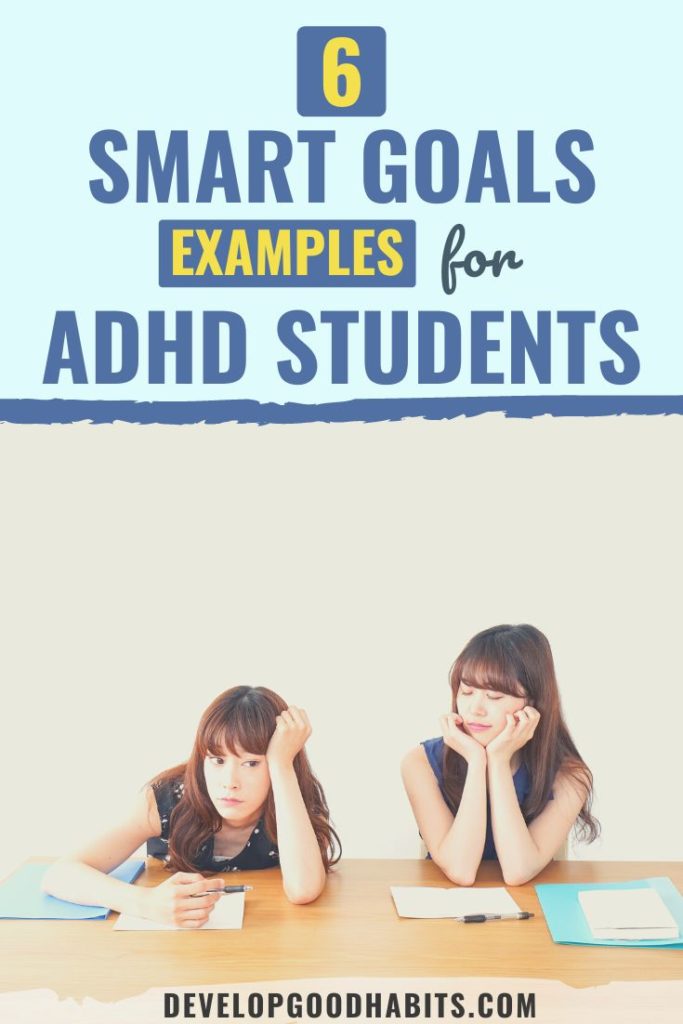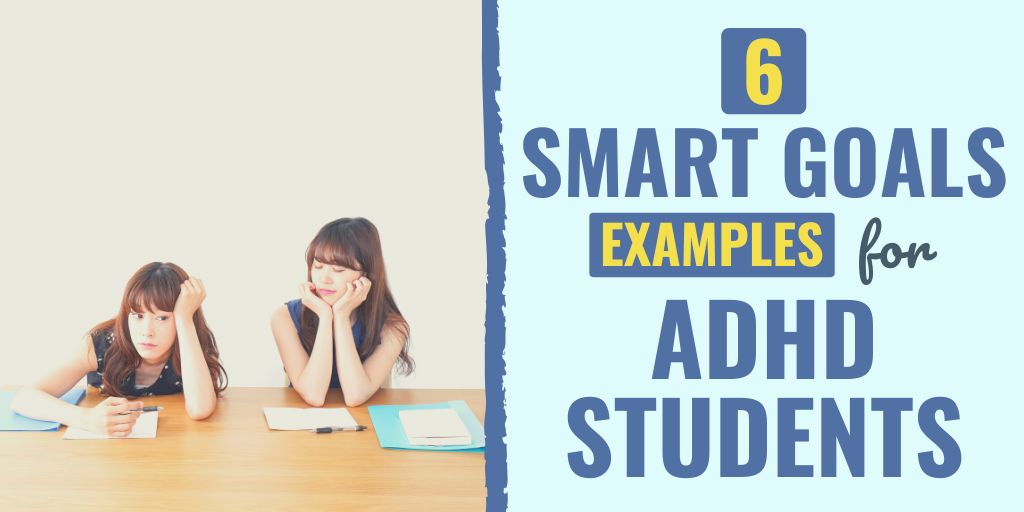There might be affiliate links on this page, which means we get a small commission of anything you buy. As an Amazon Associate we earn from qualifying purchases. Please do your own research before making any online purchase.
Being a student is hard enough as it is. However, if you have ADHD, things are much harder. Attention deficit disorder makes it difficult to concentrate, an issue for students.
If you have ADD or ADHD, you might be looking for ways to overcome the racing and distracting thoughts. One way to do this is by setting SMART goals. This article gives you 6 SMART goal examples for ADHD students.
We’ll discuss what SMART goals are and why these goals can help you overcome the obstacles created by your ADHD. Finally, we’ll provide examples of ADHD SMART goals you can base your own goals off.
What Are SMART Goals?
SMART is an acronym that relates to a specific goal-setting system. It’s a clearly defined way to set goals, proven to work to increase your chances of achieving those goals.
SMART stands for specific, measurable, attainable, relevant, and timebound. Each letter is equally important, and if you expect to achieve a goal, adhering to them is crucial. So, let’s look at what SMART means.
If you want to learn more about SMART goals, check out this Ultimate Guide to Setting SMART Goals.
Why Are SMART Goals Important for Students with ADHD?
ADHD is a learning disability that can significantly impact your life, both in and outside school. Simply concentrating on a task can be a massive challenge.
Moreover, ADHD is characterized by being unable to pay attention to anything for a prolonged period and having energy that needs to get out. Therefore, just sitting still without fidgeting and moving around is a problem.
Sitting in a classroom and concentrating on the school materials without getting distracted is not easy. This also applies to other facets of life, not just to school.

Now, SMART goals will not get rid of your ADHD, but they may be able to improve your chances of successfully paying attention in school, concentrating, and sitting still.
SMART goals provide you with a clearly defined path to achieve specific goals you set for yourself. In addition, they provide ways to monitor your progress over time.
Next, we’ll look at examples of SMART goals for ADHD students that you can base your own goals on.
6 Examples of SMART Goals for ADHD Students
1. Finish Homework within 2 Hours
“My goal is to finish all my homework within 2 hours of getting home from school instead of procrastinating indefinitely or not finishing it at all. I will turn off my phone and electronic devices to rid myself of distractions.”
S: This goal is specific—to turn off electronic devices to finish all homework within 2 hours of getting home from school.
M: This goal is measurable because you can easily track how long it takes you to finish your homework.
A: This goal is attainable because turning off electronic devices to minimize distractions is proven to work.
R: This goal is relevant because completing homework contributes to being a good student.
T: This goal is timebound—to finish your homework within two hours of school being over.
2. Increase Duration of Daily Exercise
“My goal is to gradually increase the exercise I get per day from nothing to 90 minutes to help keep my energy under control. My goal is to increase the amount of exercise by 15 minutes every 3 days until I am at 90 minutes per day. After that, I will set aside 90 minutes between 12 and 6 p.m. for weight training or cardiovascular exercise.”
S: This goal is specific—to get a certain amount of exercise per day during a particular time.
M: This goal is measurable simply by keeping track of how much you exercise daily.
A: This goal is attainable and realistic because setting aside an hour or more daily for exercise should be doable.
R: This goal is relevant because exercise is a proven method of combatting attention deficit issues.
T: This goal is timebound—to exercise a certain number of minutes daily.
3. Sit in the Front of the Classroom
“I will sit in the front of the classroom to prevent myself from being distracted by other students to limit distractions in class. In addition, I will monitor my progress by keeping track of the number of distractions I suffer from in every one-hour class. My goal is to sit in the front of every class and limit distractions to a maximum of one per class within one week of starting this process.”
S: This goal is specific—to sit at the front of the class to help pay attention.
M: This goal is measurable by keeping track of the number of times you get distracted per class.
A: This goal is attainable because sitting at the front of the class shouldn’t be a challenge.
R: This goal is relevant because minimizing distractions helps combat ADHD.
T: This goal is timebound, as it should happen in every class you have.
4. Meditate Every Day
“My goal is to begin meditating tomorrow for just 5 minutes to help center and focus my mind. After that, I will continue using various meditation techniques daily. I will practice patience and self-reflection, gradually increasing the time spent meditating daily by one minute until I can meditate for 20 consecutive minutes without distraction or interruption. This should occur within 15 days after the first meditation session.”
S: This goal is specific—to use meditation for a certain amount of time per day to help relax and clear your mind.
M: This goal can be measured by monitoring the time you successfully meditate without losing focus.
A: This goal is realistic because you start out with just a few minutes of meditation and slowly build up time.
R: This goal is relevant because meditation is proven to help combat ADHD.
T: This goal is timebound—to meditate a certain amount of time each day.
5. Seek Medical Counseling
“I will seek medical counseling starting tomorrow to help get my ADHD under control. I will see an ADHD therapist weekly and request prescription medication to help keep symptoms under control. My overall goal is to use a combination of counseling and medication to help center my mind and keep me free from distractions within one month of starting this process.”
S: This goal is specific—getting medication and counseling to help control your ADHD symptoms.
M: This goal is measurable by keeping track of how many times you see a specialist and also how many times you get distracted in a certain amount of time.
A: This goal is attainable because finding counseling should not be challenging.
R: This goal is relevant because a combination of medication and counseling is proven to help overcome ADHD.
T: This goal is timebound—to rid yourself of all distractions by the end of the month.
6. Create a Daily Schedule Every Morning
“I will create a daily schedule each morning for all of my daily responsibilities, which I will then strictly adhere to. The overall goal is to complete at least 50% of the daily tasks within the first week, 75% by the second week, and 100% by the end of the third week.”
S: This goal is specific—to create a list of daily tasks to accomplish most or all of them if possible.
M: This goal is measurable because you can do some math and determine precisely how much of your list you manage to achieve daily.
A: This goal is realistic because you start slow and work your way up.
R: This goal is relevant because being organized is another way to help overcome some of the issues caused by ADHD.
T: This goal is timebound because the aim is to complete 100% of your task list within three weeks of starting this process.
Final Thoughts on SMART Goals for ADHD Students
While ADHD is serious and not easy to overcome, there are ways to make your life easier. Using SMART goals can help increase your chances of achieving any goal you have your mind set on.
Simply define clear objectives and the means to get there; monitor your progress in real ways, and ensure you adhere to a timeline. If you do this, life as a student with ADHD should become much more manageable.
And if you want more SMART goal ideas and examples, be sure to check out these blog posts:
- 10 SMART Goals Examples for an IEP (Individualized Education Program)
- 15 SMART Goals Examples for Kids
- 7 SMART Goals Examples for Time Management & Productivity
Finally, if you want to take your goal-setting efforts to the next level, check out this FREE printable worksheet and a step-by-step process that will help you set effective SMART goals.


